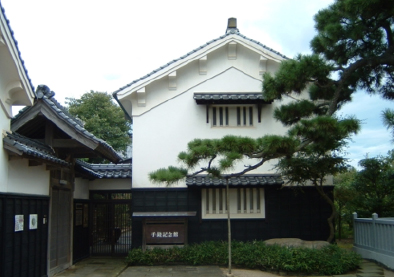Shimane has a long tradition of high-quality craftwork, including ceramics and lacquerware. A great place to learn about these traditional local crafts is the Tezen Museum in Izumo. Located a short walk from Izumo Taisha, the museum preserves a treasure trove of art and crafts passed down over generations in an important local household. The Tezen family were once grain merchants who also ran a sake brewery that produced the sacramental rice wine used at Izumo Taisha. Heads of the family served as local elders as well as stewards of the official inns reserved for high-ranking visitors to the shrine.
Thanks to such high connections, over the years the family came into possession of a number of particularly fine artworks, including paintings by Yusei Horie (1802-1873), one of the most celebrated artists of Shimane. These and other treasures go on display in rotation in the first gallery near the museum entrance, a converted rice storehouse, part of special exhibitions that change several times a year.
The sake brewery was converted into the second and larger gallery, which houses a permanent exhibition of traditional crafts of the Izumo region. Many of the pieces date from an artistic renaissance that took place under Harusato Matsudaira (1751-1818), the seventh daimyo of the Matsue clan, who in Shimane is usually referred to by his tea name, Fumai-kō. An enlightened leader who worked hard to improve the lives of his subjects, he was also a great patron of the arts.
There are two main types of ceramics associated with Izumo: Rakuzan ware, characterized by Korean-style teaware with a rustic look, and Fujina ware, with its bright glazes in blue, black and yellow. Today, just two kilns carry on the tradition of Izumo ceramics: the Unzen-gama kiln in Fujina, and the Izumoyaki Rakuzan-gama kiln. But visitors to the museum can take in beautiful examples of both styles, as well as Izumo’s local lacquerware. Don’t miss the three-tiered confection box with intricate maki-e decoration in gold and silver. The brushwork on the elegant tied-cord design is so fine that one can distinguish even the individual threads of the tassels.
The second gallery also displays several hundred articles for everyday use that date from the 19th and early 20th centuries. Standouts include a bridal trousseau brought by a woman who married into the family in 1890, including an assortment of intricate silver hairpins designed so individual ornaments can be affixed to the end. The most charming of these baubles is a miniature copy of the pulley-system seen over wells, complete with tiny buckets that move up and down on a chain. Most exhibits are captioned only in Japanese, so look for the binder, placed on a bench, that provides explanation in English. Visitors are also advised to dress for the season as the gallery has neither heat nor air-conditioning and can be chilly in the winter and warm in the summer.
Tezen Museum 手錢記念館
2450-1 Kizuki-nishi, Taisha-cho, Izumo-shi, Shimane Prefecture
島根県出雲市大社町杵築西2450-1
Phone: (0853) 53-2000
Hours: 9:00 am to 4:30 pm, closed Tuesdays, except when Tuesday falls on a national holiday, in which case closed the following day. Also closed for year-end/new year holidays and for change of exhibits.
Check website before visiting.

